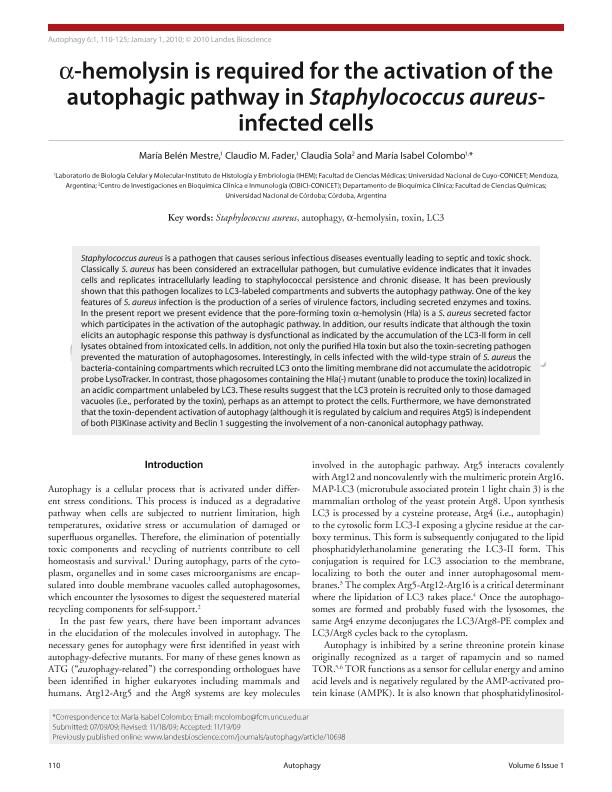Mostrar el registro sencillo del ítem
dc.contributor.author
Mestre Gimenez, Maria Belen

dc.contributor.author
Fader Kaiser, Claudio Marcelo

dc.contributor.author
Sola, Claudia del Valle

dc.contributor.author
Colombo, Maria Isabel

dc.date.available
2022-06-01T19:50:46Z
dc.date.issued
2010-01
dc.identifier.citation
Mestre Gimenez, Maria Belen; Fader Kaiser, Claudio Marcelo; Sola, Claudia del Valle; Colombo, Maria Isabel; α-hemolysin is required for the activation of the autophagic pathway in Staphylococcus aureusinfected cells; Landes Bioscience; Autophagy; 6; 1; 1-2010; 110-125
dc.identifier.issn
1554-8627
dc.identifier.uri
http://hdl.handle.net/11336/158695
dc.description.abstract
Staphylococcus aureus is a pathogen that causes serious infectious diseases eventually leading to septic and toxic shock. Classically S. aureus has been considered an extracellular pathogen, but cumulative evidence indicates that it invades cells and replicates intracellularly leading to staphylococcal persistence and chronic disease. It has been previously shown that this pathogen localizes to LC3-labeled compartments and subverts the autophagy pathway. One of the key features of S. aureus infection is the production of a series of virulence factors, including secreted enzymes and toxins. In the present report we present evidence that the pore-forming toxin α-hemolysin (Hla) is a S. aureus secreted factor which participates in the activation of the autophagic pathway. In addition, our results indicate that although the toxin elicits an autophagic response this pathway is dysfunctional as indicated by the accumulation of the LC3-II form in cell lysates obtained from intoxicated cells. In addition, not only the purified Hla toxin but also the toxin-secreting pathogen prevented the maturation of autophagosome. Interestingly, in cells infected with the wild type strain of S. aureus the bacteria-containing compartments which recruited LC3 onto the limiting membrane did not accumulate the acidotropic probe LysoTracker. In contrast, those phagosomes containing the Hla(-) mutant (unable to produce the toxin) localized in an acidic compartment unlabeled by LC3. These results suggest that the LC3 protein is recruited only to those damaged vacuoles (i. e. perforated by the toxin), perhaps as an attempt to protect the cells. Furthermore, we have demonstrated that the toxin-dependent activation of autophagy although it is regulated by calcium and requires Atg5 is independent of both PI3Kinase activity and Beclin 1 suggesting the involvement of a non-canonical autophagy pathway.
dc.format
application/pdf
dc.language.iso
eng
dc.publisher
Landes Bioscience

dc.rights
info:eu-repo/semantics/openAccess
dc.rights.uri
https://creativecommons.org/licenses/by-nc-sa/2.5/ar/
dc.subject
STAPHYLOCOCCUS AUREUS
dc.subject
AUTOPHAGY
dc.subject
Α-HEMOLYSIN
dc.subject
TOXIN
dc.subject
LC3
dc.subject.classification
Enfermedades Infecciosas

dc.subject.classification
Ciencias de la Salud

dc.subject.classification
CIENCIAS MÉDICAS Y DE LA SALUD

dc.title
α-hemolysin is required for the activation of the autophagic pathway in Staphylococcus aureusinfected cells
dc.type
info:eu-repo/semantics/article
dc.type
info:ar-repo/semantics/artículo
dc.type
info:eu-repo/semantics/publishedVersion
dc.date.updated
2022-05-20T14:27:37Z
dc.journal.volume
6
dc.journal.number
1
dc.journal.pagination
110-125
dc.journal.pais
Estados Unidos

dc.journal.ciudad
Texas
dc.description.fil
Fil: Mestre Gimenez, Maria Belen. Consejo Nacional de Investigaciones Científicas y Técnicas. Centro Científico Tecnológico Conicet - Mendoza. Instituto de Histología y Embriología de Mendoza Dr. Mario H. Burgos. Universidad Nacional de Cuyo. Facultad de Ciencias Médicas. Instituto de Histología y Embriología de Mendoza Dr. Mario H. Burgos; Argentina
dc.description.fil
Fil: Fader Kaiser, Claudio Marcelo. Consejo Nacional de Investigaciones Científicas y Técnicas. Centro Científico Tecnológico Conicet - Mendoza. Instituto de Histología y Embriología de Mendoza Dr. Mario H. Burgos. Universidad Nacional de Cuyo. Facultad de Ciencias Médicas. Instituto de Histología y Embriología de Mendoza Dr. Mario H. Burgos; Argentina
dc.description.fil
Fil: Sola, Claudia del Valle. Consejo Nacional de Investigaciones Científicas y Técnicas. Centro Científico Tecnológico Córdoba. Centro de Investigaciones en Bioquímica Clínica e Inmunología; Argentina. Universidad Nacional de Córdoba. Facultad de Ciencias Químicas. Departamento de Bioquímica Clínica; Argentina
dc.description.fil
Fil: Colombo, Maria Isabel. Consejo Nacional de Investigaciones Científicas y Técnicas. Centro Científico Tecnológico Conicet - Mendoza. Instituto de Histología y Embriología de Mendoza Dr. Mario H. Burgos. Universidad Nacional de Cuyo. Facultad de Ciencias Médicas. Instituto de Histología y Embriología de Mendoza Dr. Mario H. Burgos; Argentina
dc.journal.title
Autophagy

dc.relation.alternativeid
info:eu-repo/semantics/altIdentifier/url/https://www.tandfonline.com/doi/abs/10.4161/auto.6.1.10698
dc.relation.alternativeid
info:eu-repo/semantics/altIdentifier/doi/https://doi.org/10.4161/auto.6.1.10698
Archivos asociados
